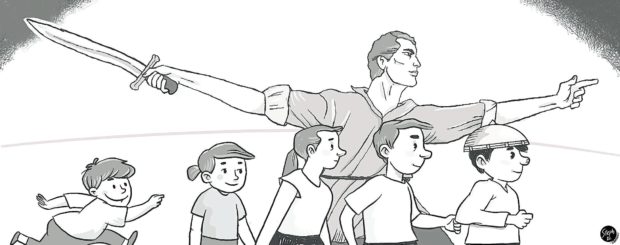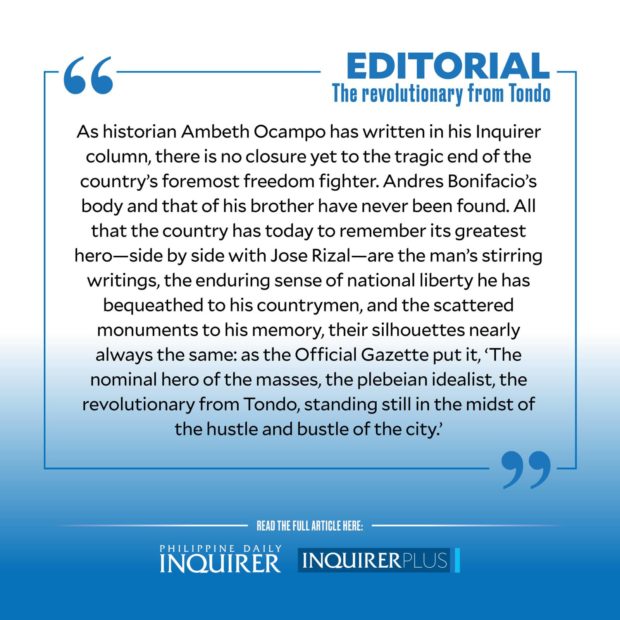The revolutionary from Tondo

In paying homage today to Andres Bonifacio, the Father of the 1896 Philippine Revolution, we can look at the numerous shrines to him around Metro Manila and elsewhere — mostly overlooked and ignored nowadays — to help us recall the singular heroism the man brought to the fight for Philippine freedom.
Of several shrines in Metro Manila, the grandest tribute to the firebrand from Tondo is undoubtedly the Andres Bonifacio Monument in Caloocan City. Designed and sculpted by National Artist Guillermo Tolentino, the iconic monument unveiled in 1933 features an obelisk with a tableau of 23 bronze figures. Bonifacio is cast as a towering hero ready to lead the battle with a bolo and a gun in his hands.
Tolentino’s notes on his winning design were recalled in a 2013 special edition of the Official Gazette to mark the 150th birth anniversary of Bonifacio as well as the 80th anniversary of the unveiling of the edifice now popularly known as “Monumento”: “The main component of the monument is a 45-foot pylon topped by the winged figure of Victory. At its base, on a platform-like structure, are the figures underlining the various causes of the Revolution. The pylon or obelisque (obelisk) is composed of five parts corresponding to the five aspects of the society, Kataastaasan, Kagalanggalang na Katipunan ng mga Anak ng Bayan (Highest and Most Venerable Association of the Sons of the Nation). The base is an octagon, the eight sides standing for the first eight provinces to rise against Spain, also represented as eight rays in the Katipunan flag. The base rises in three steps, each step alluding to each century of Spanish rule.”
Why Caloocan City? “It was there, in August 23, 1896, that Andres Bonifacio led the famous cry that sent the clear message of resistance to Spanish rule,’’ said the Official Gazette.
Putting up the monument to Bonifacio took an arduous 25 years, including a decade of “fierce clashes between Filipino politicians and American Governors-General.” But in 1929 the cornerstone was laid, and the edifice was eventually completed. In 2013, “The monument has stood for eighty years—first a solitary rise in the expanse of Caloocan, and over the years a lynchpin for the city’s landscape to form itself around,” noted the Official Gazette. “It has lent its very name to the area now dotted by establishments that had once almost furtively crept toward it, and which now threaten to tower over its Winged Victory perched forty-five feet from the ground … The Bonifacio Monument, imposing yet graceful, thus manages to both serve as gateway and landmark to the thousands that traverse it, and yet fades into the scenery for those who’ve seen it far too often for far too long.”
The second prize winner in the design contest for the Bonifacio Monument became the Pugad Lawin Shrine in Barangay Bahay Toro in Project 8, Quezon City, commemorating the site where Bonifacio rallied his forces on Aug. 23, 1896. It was there that Bonifacio, Emilio Jacinto, and other Katipuneros tore their cedulas to signal the start of the revolution against Spain, the event becoming known as the “Cry of Pugad Lawin.’’
A Bonifacio monument can also be found in Liwasang Bonifacio in front of the Manila Post Office, which, fittingly enough, has become a historic venue for political protests. And a few meters away across the Manila City Hall is the sprawling Bonifacio and the Katipunan Revolution Monument, designed by Eduardo Castrillo as the centerpiece of the city’s Bonifacio Shrine or Heroes Park.
Perhaps the most hallowed of such shrines should be the one in Maragondon, Cavite where Bonifacio and his brother Andres Procopio were executed in 1897. This place, described by historian and Inquirer columnist Ambeth Ocampo as a once beat-up destination, is now an ecotourism resort. At the Tejeros Convention of 1897 that was marred by the warring factions of the Katipunan, Bonifacio lost to Emilio Aguinaldo in the election for president of the revolutionary government. An angered Bonifacio rejected the results and drew a gun. He and his brother were sentenced to death for treason and executed on a mountain range in Maragondon on May 10, 1897.
As Ocampo has written in his Inquirer column, there is no closure yet to the tragic end of the country’s foremost freedom fighter. Bonifacio’s body and that of his brother have never been found. All that the country has today to remember its greatest hero — side by side with Jose Rizal — are the man’s stirring writings, the enduring sense of national liberty he has bequeathed to his countrymen, and the scattered monuments to his memory, their silhouettes nearly always the same: as the Official Gazette put it, “The nominal hero of the masses, the plebeian idealist, the revolutionary from Tondo, standing still in the midst of the hustle and bustle of the city.”





















